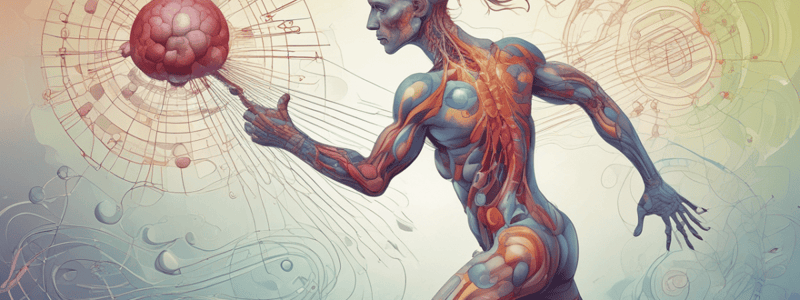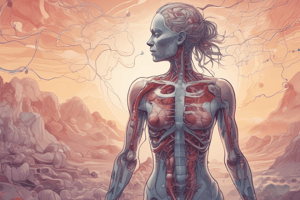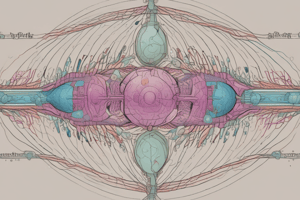Podcast
Questions and Answers
What is the effect of adrenaline on insulin secretion?
What is the effect of adrenaline on insulin secretion?
- Inhibits insulin secretion (correct)
- Stimulates insulin secretion
- Increases the storage of insulin in the pancreatic β cell
- Has no effect on insulin secretion
What is the primary function of glucagon in the body?
What is the primary function of glucagon in the body?
- To inhibit the uptake of amino acids
- To prevent hypoglycaemia after a protein meal (correct)
- To promote the synthesis of fatty acids
- To stimulate the storage of glycogen
What is the result of insulin stimulating glycogen synthesis and storage?
What is the result of insulin stimulating glycogen synthesis and storage?
- Increased storage of fatty acids
- Increased breakdown of glycogen
- Increased uptake of amino acids
- Increased storage of glucose in the form of glycogen (correct)
What is the effect of high concentrations of amino acids in the blood on glucagon secretion?
What is the effect of high concentrations of amino acids in the blood on glucagon secretion?
What is the result of insulin stimulating fatty acid synthesis and storage from CHO?
What is the result of insulin stimulating fatty acid synthesis and storage from CHO?
What is the structure of the insulin receptor?
What is the structure of the insulin receptor?
What is the primary function of the α subunit of the insulin receptor?
What is the primary function of the α subunit of the insulin receptor?
What is the effect of insulin on hormone-sensitive lipase in adipocytes?
What is the effect of insulin on hormone-sensitive lipase in adipocytes?
What is the downstream target of PI3 kinase that promotes glucose uptake?
What is the downstream target of PI3 kinase that promotes glucose uptake?
What is the role of Ras in insulin signaling?
What is the role of Ras in insulin signaling?
What is the effect of insulin on glucose transport in muscle and adipose tissue?
What is the effect of insulin on glucose transport in muscle and adipose tissue?
What is the role of the β subunit of the insulin receptor?
What is the role of the β subunit of the insulin receptor?
What is the effect of insulin on glycogen synthesis in muscle and liver?
What is the effect of insulin on glycogen synthesis in muscle and liver?
What is the role of Akt/PKB in insulin signaling?
What is the role of Akt/PKB in insulin signaling?
What is the effect of insulin on gene expression?
What is the effect of insulin on gene expression?
What is the role of IRS in insulin signaling?
What is the role of IRS in insulin signaling?
What is the characteristic of GLUT receptors in brain, liver, and erythrocyte?
What is the characteristic of GLUT receptors in brain, liver, and erythrocyte?
What happens to insulin receptors when insulin concentrations are high?
What happens to insulin receptors when insulin concentrations are high?
What is the primary function of glucagon in the liver during fasting?
What is the primary function of glucagon in the liver during fasting?
What is the effect of adrenaline on muscle and liver during stress?
What is the effect of adrenaline on muscle and liver during stress?
What is the primary function of cortisol in muscle during fasting?
What is the primary function of cortisol in muscle during fasting?
What is the characteristic of liver carbohydrate metabolism during the fed state?
What is the characteristic of liver carbohydrate metabolism during the fed state?
What is the effect of insulin on fatty acid metabolism in the liver during the fed state?
What is the effect of insulin on fatty acid metabolism in the liver during the fed state?
What is the characteristic of glucose metabolism in the brain and erythrocyte?
What is the characteristic of glucose metabolism in the brain and erythrocyte?
What is the primary function of insulin in the body?
What is the primary function of insulin in the body?
Which of the following hormones has a hyperglycaemic effect?
Which of the following hormones has a hyperglycaemic effect?
What is the approximate percentage of pancreatic mass comprised of islets of Langerhans?
What is the approximate percentage of pancreatic mass comprised of islets of Langerhans?
Which enzyme is phosphorylated in response to insulin stimulation?
Which enzyme is phosphorylated in response to insulin stimulation?
What is the primary factor that stimulates insulin secretion?
What is the primary factor that stimulates insulin secretion?
Which of the following is NOT a mechanism by which the body achieves changes in metabolic pattern?
Which of the following is NOT a mechanism by which the body achieves changes in metabolic pattern?
What is the approximate number of islets of Langerhans present in the adult pancreas?
What is the approximate number of islets of Langerhans present in the adult pancreas?
Which hormone provides fine-tuning of blood glucose homeostasis by stimulating insulin secretion?
Which hormone provides fine-tuning of blood glucose homeostasis by stimulating insulin secretion?
Flashcards are hidden until you start studying
Study Notes
Fuel Metabolism and Hormone Regulation
- The body's fuel demand is constant, but the supply is intermittent.
- Hormones regulate fuel metabolism by storing fuel when it's available and mobilizing it in times of starvation, injury, or stress.
Hormones Controlling Intermediary Metabolism
- Insulin and glucagon are the primary regulators of metabolism.
- Insulin is the only hypoglycemic hormone, while glucagon is a hyperglycemic hormone.
- Other insulin counter-regulatory hormones include adrenaline, cortisol, and growth hormone.
Islets of Langerhans
- The islets of Langerhans are the endocrine part of the pancreas, making up about 2% of the total pancreatic mass.
- The adult pancreas contains around 1 million islets.
- β cells (60-70%) secrete insulin, α cells (30-40%) secrete glucagon, and δ cells secrete somatostatin.
Insulin Secretion and Regulation
- Insulin secretion is stimulated by a rise in blood glucose, amino acid concentration, and gut hormones.
- Glucagon also stimulates insulin secretion, providing fine-tuning of blood glucose homeostasis.
- Insulin secretion is inhibited by adrenaline.
Glucagon Secretion and Regulation
- Glucagon secretion is stimulated by low blood glucose, high amino acid concentration, and adrenaline.
- Glucagon secretion is suppressed by insulin.
Metabolic Effects of Insulin
- Insulin promotes fuel storage after a meal, growth, and glycogen synthesis and storage.
- Insulin stimulates fatty acid synthesis and storage from carbohydrates when intake exceeds glycogen storage capacity.
- Insulin stimulates amino acid uptake and protein synthesis.
Insulin Receptor Structure and Signaling
- The insulin receptor consists of α and β subunits, with the α subunit binding insulin and the β subunit containing a docking site for IRS.
- Insulin binding activates the tyrosine kinase, leading to phosphorylation of IRS and activation of PI3 kinase.
- PI3 kinase activates Akt/PKB, which promotes glucose uptake and glycogen synthesis.
Metabolic Effects of Glucagon
- Glucagon mobilizes fuel, maintains blood glucose during fasting, and activates glycogenolysis, gluconeogenesis, and fatty acid release from adipose tissue.
Adrenaline and Cortisol
- Adrenaline mobilizes fuel during stress, stimulating glycogenolysis and fatty acid release from adipose tissue.
- Cortisol provides for long-term requirements, stimulating amino acid mobilization from muscle, gluconeogenesis, and fatty acid release from adipose tissue.
Blood Glucose Regulation
- Blood glucose levels, insulin, and glucagon vary after a high-carbohydrate meal and over 24 hours of normal eating behavior.
- Insulin and glucagon work together to maintain blood glucose homeostasis.
Metabolism in the Fed State
- The fed state occurs 2-4 hours after a meal, characterized by an increase in blood glucose, amino acids, and TAG as chylomicrons.
- The liver is essential in this state, receiving nutrients from the hepatic portal vein before other tissues.
- Glycogen synthesis, glycolysis, and fatty acid synthesis are activated in the liver, while gluconeogenesis is inhibited.
Liver Carbohydrate Metabolism
- The liver is engaged in gluconeogenesis at all times except the fed state, when glycolysis is activated through glucokinase.
- Glycogen synthesis is activated, and glycogen synthase is phosphorylated.
- Glycolysis is activated through PFK and pyruvate kinase.
Liver Fat Metabolism
- Fatty acid and TAG synthesis are activated in the liver, with acetyl-CoA carboxylase as the rate-limiting step.
- Malonyl-CoA inhibits carnitine transferase, directing newly synthesized FA towards TAG synthesis.
Brain and Erythrocyte Metabolism
- Both the brain and erythrocytes rely on glucose for energy.
Studying That Suits You
Use AI to generate personalized quizzes and flashcards to suit your learning preferences.




